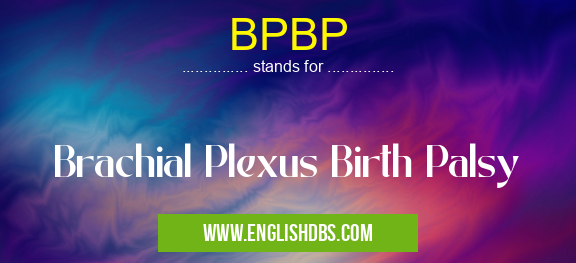What does BPBP mean in DISEASES
BPBP stands for Brachial Plexus Birth Palsy, a medical condition that occurs when the nerves controlling movement and sensation in the shoulder, arm, and hand are damaged or stretched during childbirth. This damage results in weakness, lack of muscle control, reduced sensation, and problems controlling movements in the affected area. BPBP is most commonly seen when a baby has difficulty passing through their mother’s birth canal due to the baby being large or in an awkward position.

BPBP meaning in Diseases in Medical
BPBP mostly used in an acronym Diseases in Category Medical that means Brachial Plexus Birth Palsy
Shorthand: BPBP,
Full Form: Brachial Plexus Birth Palsy
For more information of "Brachial Plexus Birth Palsy", see the section below.
What is BPBP?
Brachial plexus birth palsy (BPBP) occurs when there is damage or stretching of the brachial plexus nerves - a bundle of nerves extending from the spine down into each arm. The brachial plexus control movement and sensation to the arm, shoulder and hand. When these nerves become damaged or stretched during birth this can cause muscular weakness, loss of sensation and difficulty controlling movements in the affected area. The most common cause of BPBP is when a baby has difficulty passing through their mother's birth canal due to being large or being positioned awkwardly. Other causes can include excessive traction on the neck or shoulders during delivery or certain medical interventions such as instrument-assisted deliveries like forceps or vacuum extractors. It's also necessary to consider genetic predispositions which may contribute to risk factors that increase one’s chances of developing this condition at birth.
Symptoms
The symptoms of a baby suffering from BPBP vary depending on how severely the nerve was damaged during childbirth but can include decreased mobility in the affected extremity, lack of feeling or sensations/numbness, limb paralysis, weak grip strength and reduced ability to move normally in comparison with other unaffected limbs (asymmetry). In some cases where only a few nerve fibers are affected babies may experience no symptoms whereas serious cases can result in permanent disability requiring long-term management throughout life.
Diagnosis
If Brachial Plexus Birth Palsy is suspected then your doctor should perform a physical examination to evaluate muscle strength and reflexes as well as assess how well your baby can move his/her extremities. Further scans may be conducted including X-rays and MRI scans to assess any possible damage done directly to the bones associated with nerve compression or injury as well as measure any fluid accumulation around affected areas - both indicating that BPBP may be present. Depending on results further tests may be recommended before treatments begin.
Treatment
Depending on severity there are various treatment options available for BPBP including physiotherapy exercises which help regain muscle strength and flexibility; splinting which provides support for weakened muscles; electrical stimulation which helps reduce spasticity; Botox injections which relax tight muscles; surgical reconstruction of damaged nerves; occupational therapy; speech therapy if needed; bracing if necessary; orthotics if required; anti-inflammatory medications to reduce pain; supportive counseling from professionals who understand specific difficulties associated with this condition; alternative therapies such as yoga or tai chi etc..
Essential Questions and Answers on Brachial Plexus Birth Palsy in "MEDICAL»DISEASES"
What is Brachial Plexus Birth Palsy?
Brachial Plexus Birth Palsy (BP) is a birth injury to the nerves in an infant’s neck that can cause temporary or permanent disability of one arm. The severity of symptoms ranges from arm weakness and lack of grip strength to paralysis.
What causes Brachial Plexus Birth Palsy?
BP is typically caused by traumatic stretching or compression of the brachial plexus nerves, which run between the neck and shoulder. This can occur when an infant’s shoulders become stuck during delivery, resulting in excessive force on the neck area.
What are the symptoms of Brachial Plexus Birth Palsy?
Symptoms vary depending on the severity of nerve damage but can include flaccid paralysis (little or no movement) in the affected limb, abnormal head position, lack of muscle control in one arm, joint instability, and decreased range of motion.
How is Brachial Plexus Birth Palsy diagnosed?
A diagnosis for BP may be made through a physical exam where your doctor will test reflexes and movement responses as well as imaging studies such as an X-Ray or MRI. The diagnosis can also be confirmed through electrical studies like EMG/NCV testing.
Is there a cure for Brachial Plexus Birth Palsy?
Unfortunately, there is currently no cure for BP; however, treatment options may help improve mobility, strength and function in the affected limb. Treatments can include physical therapy, occupational therapy or surgery.
Does my child need treatment if he/she has been diagnosed with Brachial Plexus Birth Palsy?
Yes - early intervention with specialized therapies can maximize recovery potential and improve outcomes for children diagnosed with BP. It’s best to speak with your healthcare provider about what would work best for your child’s individual situation.
Is it possible for babies with Brachial Plexus Birth Palsy to make a full recovery?
While complete resolution is rare, many infants are able to regain some level of movement after receiving appropriate treatments. Some children may require additional therapies later on in childhood or adolescence to maintain long-term functionality of their affected limb(s).
Are there any known long-term effects associated with Brachial Plexus Birth Palsy?
In some cases, complications such as arthritis in joints may develop later in life due to abnormal use patterns over time due to limited mobility or range of motion caused by minor paralysis or immobility present at birth from BP.
Final Words:
Brachial Plexus Birth Palsy can have significant consequences for both babies and their families throughout life so it’s important that it is diagnosed early on so appropriate treatments can begin immediately before any long lasting effects take hold. With early diagnosis steps are taken quickly to address any possible damage caused by BPBP thus enabling babies and parents alike peace of mind moving forward.
